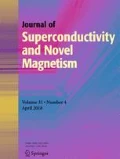Abstract
We implement the rotationally-invariant formulation of the two-dimensional Hubbard model, with nearest-neighbors hopping t, which allows for the analytic study of the system in the low-energy limit. Both U(1) and SU(2) gauge transformations are used to factorize the charge and spin contribution to the original electron operator in terms of the corresponding gauge fields. The Hubbard Coulomb energy U-term is then expressed in terms of quantum phase variables conjugate to the local charge and variable spin quantization axis, providing a useful representation of strongly correlated systems. It is shown that these gauge fields play a similar role as phonons in the BCS theory: they act as the “glue” for fermion pairing. By tracing out gauge degrees of freedom the form of paired states is established and the strength of the pairing potential is determined. It is found that the attractive pairing potential in the effective low-energy fermionic action is non-zero in a rather narrow range of U/t.
Similar content being viewed by others
References
Bardeen, J., Cooper, L.N., Schrieffer, J.R.: Phys. Rev. 108, 1175 (1957)
Bednorz, J.G., Müller, K.A.: Z. Phys. B: Condens. Matter 64, 189 (1986)
Anderson, P.W.: Science 317, 1705 (2007)
Hirsch, J.E.: Phys. Rev. B 31, 4403 (1985)
Furukawa, N., Imada, M.: J. Phys. Soc. Jpn. 61, 3331 (1992)
Fano, G., Ortolani, F., Parola, A.: Phys. Rev. B 42, 6877 (1990)
Dagotto, E., Moreo, A., Ortolani, F., Poilblanc, D., Riera, J.: Phys. Rev. B 45, 10741 (1992)
Kashima, T., Imada, M.: J. Phys. Soc. Jpn. 70, 2287 (2001)
Rohe, D., Metzner, W.: Phys. Rev. B 71, 115116 (2005)
Maier, T., Jarrell, M., Pruschke, T., Hettler, M.H.: Rev. Mod. Phys. 77, 1027 (2005)
Maier, T.A., Jarrell, M.S., Scalapino, D.J.: Phys. Rev. Lett. 96, 047005 (2006)
Maier, T.A., Jarrell, M., Scalapino, D.J.: Phys. Rev. B 74, 094513 (2006)
Monthoux, P., Scalapino, D.J.: Phys. Rev. Lett. 72, 1874 (1994)
Kopeć, T.K.: Phys. Rev. B 73, 132512 (2006)
Zaleski, T.A., Kopeć, T.K.: Phys. Rev. B 77, 125120 (2008)
Negele, J.W., Orland, H.: In: Quantum Many Particle Systems. Frontiers in Physics, Addison-Wesley (1988)
Schulz, H.J.: Phys. Rev. Lett. 65, 2462 (1990)
Author information
Authors and Affiliations
Corresponding author
Rights and permissions
About this article
Cite this article
Apinyan, V.A., Kopeć, T.K. Emergence of Pairing Interaction in the Hubbard Model in the Strong Coupling Limit. J Supercond Nov Magn 22, 57–61 (2009). https://doi.org/10.1007/s10948-008-0356-6
Received:
Accepted:
Published:
Issue Date:
DOI: https://doi.org/10.1007/s10948-008-0356-6


